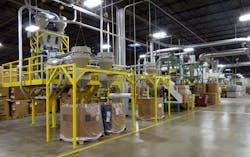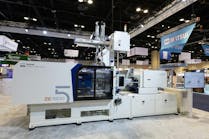By Ron Shinn
The management team at Butler-MacDonald had spent more than a year assessing its operation, talking to customers and evaluating equipment to give the Indianapolis recycler and recycled resin supplier new capabilities and faster turnaround times in the future.
But just as it was about to sign a hefty contract with Erema North America Inc., Ipswich, Mass., for a new recycling line, the COVID-19 pandemic cast uncertainty over the industry.
“We were in the final stages of negotiating a contract with Erema,” said J. Scott Johnson, CEO and president. “We could have pulled out right then and there because we had not signed anything, and no money had transferred.
“But we took a week to think about it and one of the advantages you have from being in business 38 years is you realize that for every setback there is an equal or better recovery,” Johnson said. “I refused to give in to the idea that now was the time to give up. We went ahead and made the purchase and I still feel as strong about that decision now as I did back then, if not stronger.”
Butler-MacDonald’s management recognized a growing demand to recycle lighter, thin-walled containers that it could not profitably meet with its current equipment. “We realized we needed to make a substantial upgrade to be relevant going forward,” Johnson said.
“We also realized that it wasn’t just the extruder but everything leading up to the extruder and after the extruder that all had to be addressed,” he said.
So, the company worked with Erema to build a new extrusion system that includes proprietary design modifications. That was the catalyst behind buying Erema equipment, Johnson said. “They were willing to adapt to our needs.”
One example is the inclusion of a DSW 40 twin-screw stuffer that allows the injection of additives directly into the barrel of the extruder. The advantage is more-homogeneous blends and less chance of stratification in the preconditioning unit, plus a potential reduction in additive costs, Johnson said.
“It is a universal machine that will process a wide range of materials, and we run a lot of different polymers,” Johnson said.
The new extrusion system is an Intarema 1714 TVEplus. It is specially designed for materials that are difficult to recycle, such as heavily printed film and very moist materials. Erema said the machine features ultrafine filtration, thorough melt homogenization and high-performance degassing in a single step.
Melt filtration takes place upstream of extruder degassing, which results in higher-quality recycled pellets, according to Erema.
The Intarema TVEplus machines also feature Erema’s patented Counter Current technology that increases throughput by changing the direction of rotation inside the cutter/compactor. The plastic material moves in the opposite direction of the extruder screw. The speed of the material increases and the extruder acts as a sharp edge and cuts up the plastic. In addition to the extruder screw being filled nearly pressure-free with preheated material, it can also be processed at lower temperatures at high throughput.
“It makes the geometry as efficient as possible,” said Greg Wool, VP of sales at Erema North America. “We can get the same throughput with a smaller system, so it is energy-efficient and takes less capital cost up front.”
The new line with a 140mm extruder is scheduled to go into operation at Butler-MacDonald in mid-December. At full capacity, it will have an average throughput of about 3,600 pounds per hour, depending on the plastic being processed. Johnson said it will add about 22 million pounds per year to his company’s total output.
The additional capacity is not the key point, Johnson said.
“It takes an entire segment of business that we have not been able to do and adds it to the bottom line,” he said. “We are hoping that 30 percent or more of those pounds are from entirely new sources. Our company in the past has not been very competitive in working with products that weigh much less than 15 to 18 pounds per cubic foot. This enables us to be competitive with products that could be all the way down to 6 pounds per cubic foot.”
The new system will also significantly reduce Butler-MacDonald’s turnaround time from the current average of five to six weeks to just one to two weeks. “A lot of our customers are brokers or other recyclers we do the work for,” Johnson said. “They have money invested and they want to get it turned into something profitable as quickly as possible.”
The company always faces challenges for receiving material and getting it prepped and into the machine, Johnson said. “Everything from how we dump containers, which today is going more and more to bags as opposed to boxes, into something that would feed it and enable us to deal with contamination in the material. We have to be able to handle it efficiently to make money at it,” he said.
The solution is a system designed in-house. “Our system is totally proprietary. We buy a lot of equipment but how we link it together is our proprietary solution. It gives us our edge over competitors,” Johnson said.
Contracts for auxiliary equipment for the new line had not yet been awarded at the time Johnson was interviewed, but he said the company was considering National Bulk Equipment feeders and conveyors; Flexicon conveyors; equipment from Eriez, Bunting Magnetics and Loma metal detectors; Conair vacuum loaders and vacuum pumps; and perhaps Conair TrueBlend feeders in combination with a Maguire blending system.
On the other end of the extruder, Butler-MacDonald will use an Erema HG 344D hot-die-face pelletizer with direct-drive technology and an Erema vibration table for cooling and drying pellets. When pellets come off the line they are as close as possible to being immediately ready for packaging and are dried, which was a feature that Butler-MacDonald wanted.
“Hopefully, for us it will save a lot of material movement in the warehouse,” Johnson said. “As pellets have come off our previous lines, they have had to sit in the warehouse for two to four days single-stacked to cool prior to being packed. When you are generating 5,000 pounds an hour you can eat up a lot of warehouse space. We are hoping that this new system reduces warehouse space to about a quarter of what it used to take.”
John Capece, sales manager at Erema North America, said the HG 344D pelletizer is “very user friendly and handles a variety of different polymers and melt flows. Our pelletizers are simple to run, very versatile and easy to maintain.”
Conair is contributing to the vacuum loader system that will pull these pellets away from the pelletizer.
Erema has also developed a scale that Butler-MacDonald will use for measuring production throughput, quantity of pellets in real time and total weight. Individual filling of boxes and bags is also possible to an accuracy of 0.25 percent so the company will know exactly how many pounds are being packaged.
“One thing the pandemic has done is it has taken our business from feast to famine and hopefully we are on our way back to feast again,” Johnson said. “The second week in May we hit a brick wall and business fell off. We had to adjust with pricing and [turnaround] time. Business has really picked up over the last 45 days. We hope the world is becoming more used to maneuvering through the pandemic.”
Johnson said the increase in demand has put a focus on warehouse space. “If we have warehouse space consumed by products waiting to be shipped, there comes to a point where we cannot bring any more products in until we ship some out. Hopefully we will be able to turn products much faster.”
Butler-MacDonald does not currently recycle film. “We recycle a lot of rigid plastics but over the years rigid plastics have become thinner and thinner,” Johnson said. “There is a wide range of packaging out there that is much thinner, much lighter and much more difficult to recycle. We believe we can be really successful in dealing with those products going forward.”
Cost of the project is about $2.5 million, with new equipment costing about $2.1 million of the total.
“This line will process a wider range of materials and even set us up for the future if we decide to go into recycling film,” Johnson said. “Our other extrusion lines cannot do that without substantial modifications. That becomes cost-prohibitive to do. With this line, anything from extremely light, wet film to heavy pallets can run through it and that makes it a little more future-proof for us.”
Butler-MacDonald does not extrude PET. “We do a lot with PET for material separation. There are too many companies that specialize in extruding it. That’s not our niche,” Johnson said.
The new Erema line will give Butler-MacDonald a total of 12 lines. The company has about 55 employees working shifts 24 hours a day, six days per week. Johnson said he is trying to hire 15 to 20 more employees.
Ron Shinn, editor
Contact:
Butler-MacDonald Inc., Indianapolis, 317-872-5115, www.butlermacdonald.com
Ron Shinn | Editor
Editor Ron Shinn is a co-founder of Plastics Machinery & Manufacturing and has been covering the plastics industry for more than 35 years. He leads the editorial team, directs coverage and sets the editorial calendar. He also writes features, including the Talking Points column and On the Factory Floor, and covers recycling and sustainability for PMM and Plastics Recycling.






